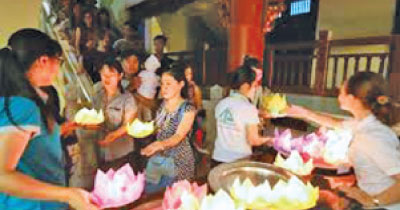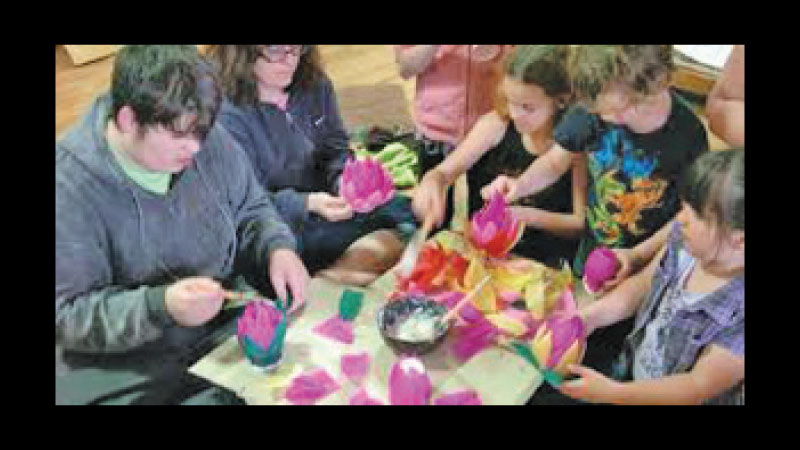Vesak is a sacred occasion that holds deep spiritual, cultural, and historical meaning for Buddhists around the world. It commemorates the triple events in the life of Siddhartha Gautama—the Birth, Enlightenment, and Passing Away of the Buddha.
For adults, it is a time of solemn reflection and renewal of vows, a moment to return to the Dhamma and rededicate themselves to the Eightfold Path. For children, however, Vesak offers more than just religious observance; it is a gateway to learning the foundational values of Buddhism—compassion, kindness, mindfulness, generosity, and wisdom. Teaching these values during Vesak is not only an act of spiritual instruction but a lasting investment in the moral and emotional development of the next generation.
Children today grow up in a world that is fast-paced, often competitive, and saturated with distractions. The digital age has brought with it both unprecedented opportunities and unique challenges—exposure to global cultures, instant information, and technological advancement on one hand; and isolation, superficial relationships, and diminishing attention spans on the other.
In such an environment, Vesak stands as a timeless reminder of what truly matters: inner peace, human connection, and ethical living. Instilling these virtues in children, especially during Vesak, helps anchor them to a moral compass that can guide them throughout their lives.
The first and perhaps most important value to teach children during Vesak is compassion. At the heart of the Buddha’s teachings lies the principle of karuna—compassion for all living beings. Vesak provides countless opportunities to cultivate this virtue in children, not through abstract lectures, but through meaningful action.
Involving children in community service, such as visiting elders, feeding stray animals, helping with dansals (free food stalls), or preparing donations for those in need, can offer profound lessons. When children participate in acts of giving and care, they begin to understand the power of kindness. These acts foster empathy and help children see the world not only through their own eyes but from the perspective of others.
 Equally vital is the teaching of generosity or dana. Children are naturally generous in spirit, but they often need guidance in understanding structured, selfless giving. Vesak is an ideal time to encourage this. Involving them in small, age-appropriate offerings—be it lighting an oil lamp, offering flowers to a Buddha statue, or donating their toys or clothes to those less fortunate—imbues a sense of humility and joy in giving.
Equally vital is the teaching of generosity or dana. Children are naturally generous in spirit, but they often need guidance in understanding structured, selfless giving. Vesak is an ideal time to encourage this. Involving them in small, age-appropriate offerings—be it lighting an oil lamp, offering flowers to a Buddha statue, or donating their toys or clothes to those less fortunate—imbues a sense of humility and joy in giving.
Parents and educators can explain the importance of giving without expecting anything in return, showing how even the smallest act can bring happiness to both giver and receiver. This early introduction to dana can help children resist the materialism so prevalent in modern society and cultivate a life of sharing.
Mindfulness is another core Buddhist value that can be gently introduced to children during Vesak. In the hustle and bustle of daily life, children, like adults, are often swept up in a torrent of activity. Vesak offers a calm space where they can begin to understand and practise mindfulness. Simple activities such as silent walking, mindful breathing, or even watching the flicker of a Vesak lantern can help bring awareness to the present moment. Temple visits, chanting sessions, and stories from the Jataka tales are excellent opportunities to help children reflect quietly, observe their thoughts, and become more attentive. When children are taught to pause, to be present, and to listen deeply, they develop emotional intelligence and resilience—skills that are essential for life.
Another enriching dimension of Vesak is its storytelling tradition. The life of the Buddha and the moral parables of the Jataka stories contain timeless wisdom, wrapped in engaging narratives that children can relate to. These stories teach values such as truthfulness, patience, humility, courage, and the consequences of one’s actions.
Reading or narrating these stories in an interactive way can leave a lasting impact on young minds. Instead of treating them as mere folklore, adults can use them as tools for discussion—asking children what they learned, how they would have acted in similar situations, and what choices they would make. Storytelling in this context becomes not only educational but transformative.
Parents and teachers play a vital role in making Vesak meaningful for children. Children learn best by observing, and when they see adults engaging in spiritual practices with sincerity—observing sil, practicing meditation, preparing lanterns or alms, treating others with compassion—they are more likely to follow suit.
A family that worships together, volunteers together, and discusses moral choices together creates an environment where values are not imposed but experienced. Celebrating Vesak at home by decorating the space with lanterns, setting up a small altar, or even dedicating time to digital detox and reflection can make the occasion more personal and relevant.
Schools and Dhamma schools too can play a powerful role during Vesak week. Many organize essay competitions, art projects, plays, and exhibitions based on Buddhist teachings. These activities allow children to express their understanding of Vesak creatively while reinforcing its values.
For example, drawing a scene from a Jataka tale, acting out a Buddhist parable, or writing a poem about the Buddha’s life encourages deeper engagement. Involving children in the preparation of decorations or planning of Vesak events empowers them with a sense of responsibility and ownership, which in turn builds confidence and teamwork.
In the digital age, Buddhist organizations and educators can also use online platforms to teach children the values of Vesak. Interactive videos, educational apps, animated Jataka tales, and virtual Dhamma sessions can supplement traditional methods, making learning more engaging and accessible.
However, it is equally important to strike a balance and ensure that digital tools serve as bridges to deeper understanding rather than distractions. Encouraging children to reflect on what they’ve learned, or even keep a “Vesak journal,” can help internalize these lessons.
Teaching the values of Vesak should not be confined to a single day or week. While Vesak serves as an excellent focal point, the values it promotes must be nurtured continuously. Children benefit when these principles are woven into the fabric of everyday life. Praising honest behaviour, encouraging them to resolve conflicts peacefully, involving them in acts of kindness, or simply listening to them with compassion are all ways to reinforce these values year-round. The spirit of Vesak—peace, compassion, and mindfulness—should not flicker out with the lanterns, but continue to illuminate the child’s path long after the festivities have ended.
Another profound lesson Vesak offers is the transient nature of life. Children, especially as they grow older, can begin to grasp the concept of impermanence. Watching the slow melting of an oil lamp, or the soft fading of a paper lantern, can serve as gentle metaphors for the passage of time. Such experiences, when explained with sensitivity, can help children develop a healthy perspective on loss, change, and growth. They learn to appreciate the moment and to let go of attachments gracefully—a lesson that lies at the very heart of Buddhism.
Teaching children the values of Vesak is not about indoctrination but illumination. It is about planting seeds of wisdom and compassion that can bloom in their own time, in their own way. Each child’s spiritual journey is unique, and Vesak offers an inclusive, inspiring, and joyful entry point into that journey. When guided with patience, love, and understanding, children can discover in Vesak not just a festival of lights, but a beacon that guides them towards becoming kind, wise, and conscious human beings.
In a world that often feels hurried, competitive, and fractured, the quiet grace of Vesak—and the timeless truths it teaches—can offer children an inner sanctuary. By helping them understand the essence of this sacred day, we are not only preserving a cultural heritage but shaping a future where empathy, peace, and mindfulness are not ideals from the past, but realities of the present. Vesak, then, becomes not just a day to remember the Buddha—but a day to help children discover the Buddha within.







